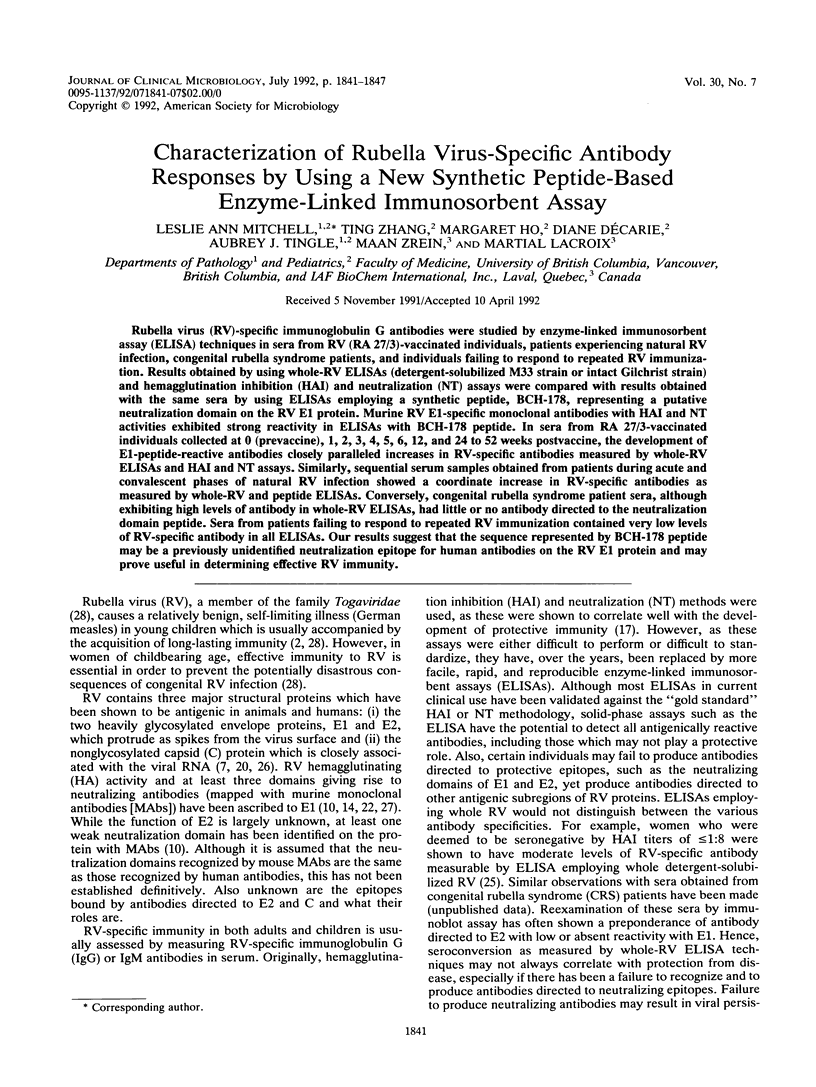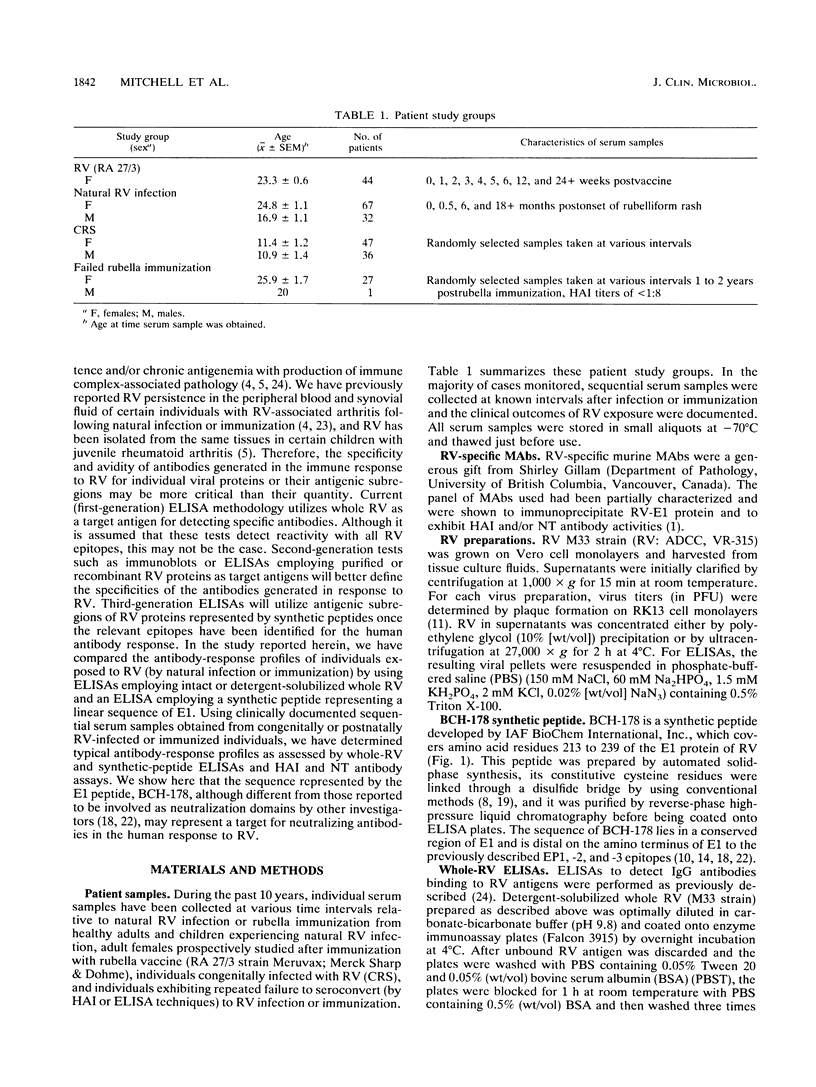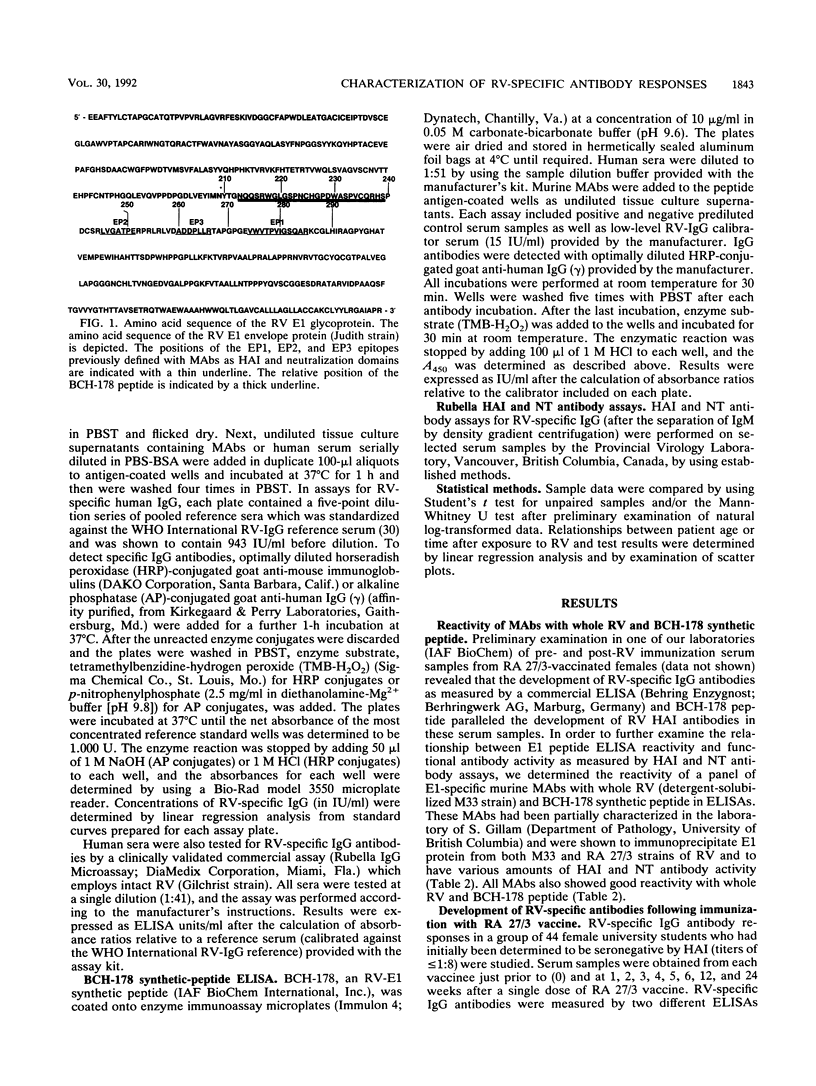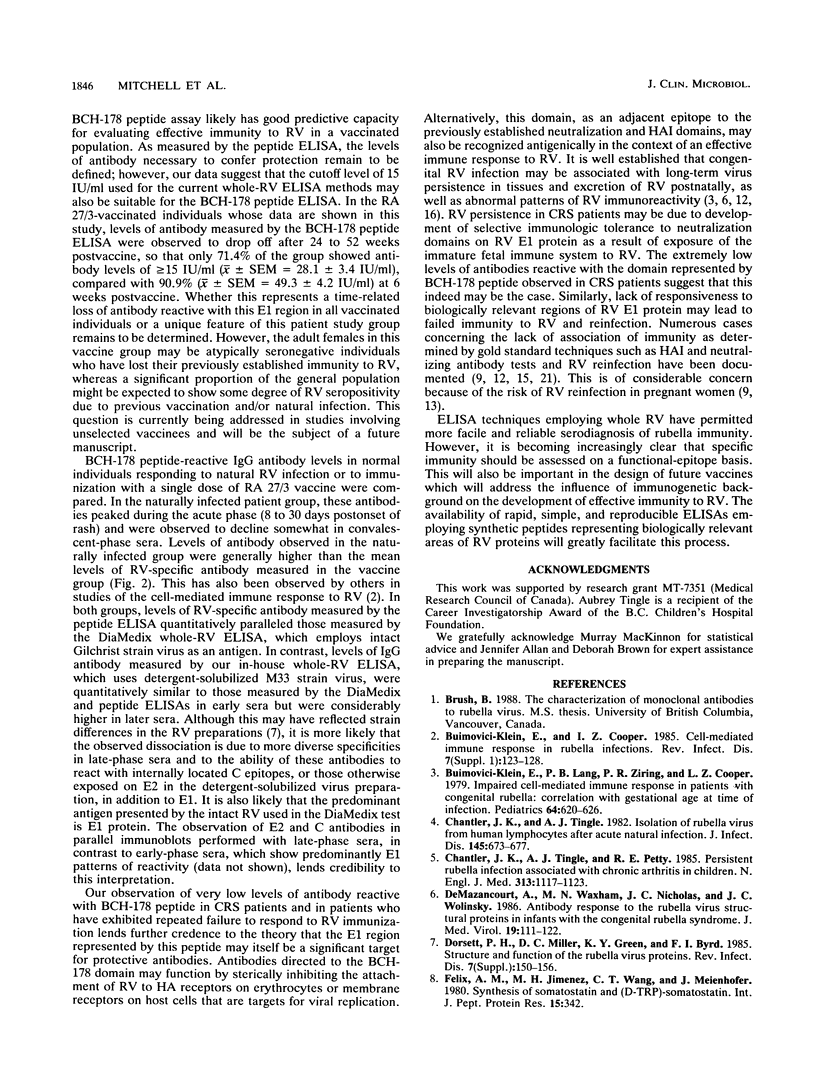Abstract
Rubella virus (RV)-specific immunoglobulin G antibodies were studied by enzyme-linked immunosorbent assay (ELISA) techniques in sera from RV (RA 27/3)-vaccinated individuals, patients experiencing natural RV infection, congenital rubella syndrome patients, and individuals failing to respond to repeated RV immunization. Results obtained by using whole-RV ELISAs (detergent-solubilized M33 strain or intact Gilchrist strain) and hemagglutination inhibition (HAI) and neutralization (NT) assays were compared with results obtained with the same sera by using ELISAs employing a synthetic peptide, BCH-178, representing a putative neutralization domain on the RV E1 protein. Murine RV E1-specific monoclonal antibodies with HAI and NT activities exhibited strong reactivity in ELISAs with BCH-178 peptide. In sera from RA 27/3-vaccinated individuals collected at 0 (prevaccine), 1, 2, 3, 4, 5, 6, 12, and 24 to 52 weeks postvaccine, the development of E1-peptide-reactive antibodies closely paralleled increases in RV-specific antibodies measured by whole-RV ELISAs and HAI and NT assays. Similarly, sequential serum samples obtained from patients during acute and convalescent phases of natural RV infection showed a coordinate increase in RV-specific antibodies as measured by whole-RV and peptide ELISAs. Conversely, congenital rubella syndrome patient sera, although exhibiting high levels of antibody in whole-RV ELISAs, had little or no antibody directed to the neutralization domain peptide. Sera from patients failing to respond to repeated RV immunization contained very low levels of RV-specific antibody in all ELISAs. Our results that the sequence represented by BCH-178 peptide may be a previously unidentified neutralization epitope for human antibodies on the RV E1 protein and may prove useful in determining effective RV immunity.
Full text
PDF






Selected References
These references are in PubMed. This may not be the complete list of references from this article.
- Buimovici-Klein E., Lang P. B., Ziring P. R., Cooper L. Z. Impaired cell-mediated immune response in patients with congenital rubella: correlation with gestational age at time of infection. Pediatrics. 1979 Nov;64(5):620–626. [PubMed] [Google Scholar]
- Burman L. A., Norrby R., Trollfors B. Invasive pneumococcal infections: incidence, predisposing factors, and prognosis. Rev Infect Dis. 1985 Mar-Apr;7(2):133–142. doi: 10.1093/clinids/7.2.133. [DOI] [PubMed] [Google Scholar]
- Chantler J. K., Tingle A. J. Isolation of rubella virus from human lymphocytes after acute natural infection. J Infect Dis. 1982 May;145(5):673–677. doi: 10.1093/infdis/145.2.673. [DOI] [PubMed] [Google Scholar]
- Chantler J. K., Tingle A. J., Petty R. E. Persistent rubella virus infection associated with chronic arthritis in children. N Engl J Med. 1985 Oct 31;313(18):1117–1123. doi: 10.1056/NEJM198510313131803. [DOI] [PubMed] [Google Scholar]
- Felix A. M., Jimenez M. H., Wang C. T., Meienhofer J. Synthesis of somatostatin and [D-Trp8]-somatostatin. Int J Pept Protein Res. 1980 Apr;15(4):342–354. doi: 10.1111/j.1399-3011.1980.tb02911.x. [DOI] [PubMed] [Google Scholar]
- Forsgren M., Sörén L. Subclinical rubella reinfection in vaccinated women with rubella-specific IgM response during pregnancy and transmission of virus to the fetus. Scand J Infect Dis. 1985;17(4):337–341. doi: 10.3109/13813458509058772. [DOI] [PubMed] [Google Scholar]
- Green K. Y., Dorsett P. H. Rubella virus antigens: localization of epitopes involved in hemagglutination and neutralization by using monoclonal antibodies. J Virol. 1986 Mar;57(3):893–898. doi: 10.1128/jvi.57.3.893-898.1986. [DOI] [PMC free article] [PubMed] [Google Scholar]
- Hancock E. J., Pot K., Puterman M. L., Tingle A. J. Lack of association between titers of HAI antibody and whole-virus ELISA values for patients with congenital rubella syndrome. J Infect Dis. 1986 Dec;154(6):1031–1033. doi: 10.1093/infdis/154.6.1031. [DOI] [PubMed] [Google Scholar]
- Ho-Terry L., Terry G. M., Cohen A., Londesborough P. Immunological characterisation of the rubella E 1 glycoprotein. Brief report. Arch Virol. 1986;90(1-2):145–152. doi: 10.1007/BF01314152. [DOI] [PubMed] [Google Scholar]
- Hornstein L., Levy U., Fogel A. Clinical rubella with virus transmission to the fetus in a pregnant woman considered to be immune. N Engl J Med. 1988 Nov 24;319(21):1415–1416. [PubMed] [Google Scholar]
- Katow S., Sugiura A. Antibody response to individual rubella virus proteins in congenital and other rubella virus infections. J Clin Microbiol. 1985 Mar;21(3):449–451. doi: 10.1128/jcm.21.3.449-451.1985. [DOI] [PMC free article] [PubMed] [Google Scholar]
- Lennette E. H., Schmidt N. J., Magoffin R. L. The hemagglutination inhibition test for rubella: a comparison of its sensitivity to that of neutralization, complement fixation and fluorescent antibody tests for diagnosis of infection and determination of immunity status. J Immunol. 1967 Oct;99(4):785–793. [PubMed] [Google Scholar]
- Lozzi L., Rustici M., Corti M., Cusi M. G., Valensin P. E., Bracci L., Santucci A., Soldani P., Spreafico A., Neri P. Structure of rubella E1 glycoprotein epitopes established by multiple peptide synthesis. Arch Virol. 1990;110(3-4):271–276. doi: 10.1007/BF01311295. [DOI] [PubMed] [Google Scholar]
- Merrifield B. Solid phase synthesis. Science. 1986 Apr 18;232(4748):341–347. doi: 10.1126/science.3961484. [DOI] [PubMed] [Google Scholar]
- Serdula M. K., Halstead S. B., Wiebenga N. H., Herrmann K. L. Serological response to rubella revaccination. JAMA. 1984 Apr 20;251(15):1974–1977. [PubMed] [Google Scholar]
- Terry G. M., Ho-Terry L., Londesborough P., Rees K. R. Localization of the rubella E1 epitopes. Arch Virol. 1988;98(3-4):189–197. doi: 10.1007/BF01322168. [DOI] [PubMed] [Google Scholar]
- Tingle A. J., Allen M., Petty R. E., Kettyls G. D., Chantler J. K. Rubella-associated arthritis. I. Comparative study of joint manifestations associated with natural rubella infection and RA 27/3 rubella immunisation. Ann Rheum Dis. 1986 Feb;45(2):110–114. doi: 10.1136/ard.45.2.110. [DOI] [PMC free article] [PubMed] [Google Scholar]
- Tingle A. J., Chantler J. K., Pot K. H., Paty D. W., Ford D. K. Postpartum rubella immunization: association with development of prolonged arthritis, neurological sequelae, and chronic rubella viremia. J Infect Dis. 1985 Sep;152(3):606–612. doi: 10.1093/infdis/152.3.606. [DOI] [PubMed] [Google Scholar]
- Tingle A. J., Yang T., Allen M., Kettyls G. D., Larke R. P., Schulzer M. Prospective immunological assessment of arthritis induced by rubella vaccine. Infect Immun. 1983 Apr;40(1):22–28. doi: 10.1128/iai.40.1.22-28.1983. [DOI] [PMC free article] [PubMed] [Google Scholar]
- Waxham M. N., Wolinsky J. S. Detailed immunologic analysis of the structural polypeptides of rubella virus using monoclonal antibodies. Virology. 1985 May;143(1):153–165. doi: 10.1016/0042-6822(85)90104-7. [DOI] [PubMed] [Google Scholar]
- Wolinsky J. S., McCarthy M., Allen-Cannady O., Moore W. T., Jin R., Cao S. N., Lovett A., Simmons D. Monoclonal antibody-defined epitope map of expressed rubella virus protein domains. J Virol. 1991 Aug;65(8):3986–3994. doi: 10.1128/jvi.65.8.3986-3994.1991. [DOI] [PMC free article] [PubMed] [Google Scholar]
- de Mazancourt A., Waxham M. N., Nicolas J. C., Wolinsky J. S. Antibody response to the rubella virus structural proteins in infants with the congenital rubella syndrome. J Med Virol. 1986 Jun;19(2):111–122. doi: 10.1002/jmv.1890190203. [DOI] [PubMed] [Google Scholar]


